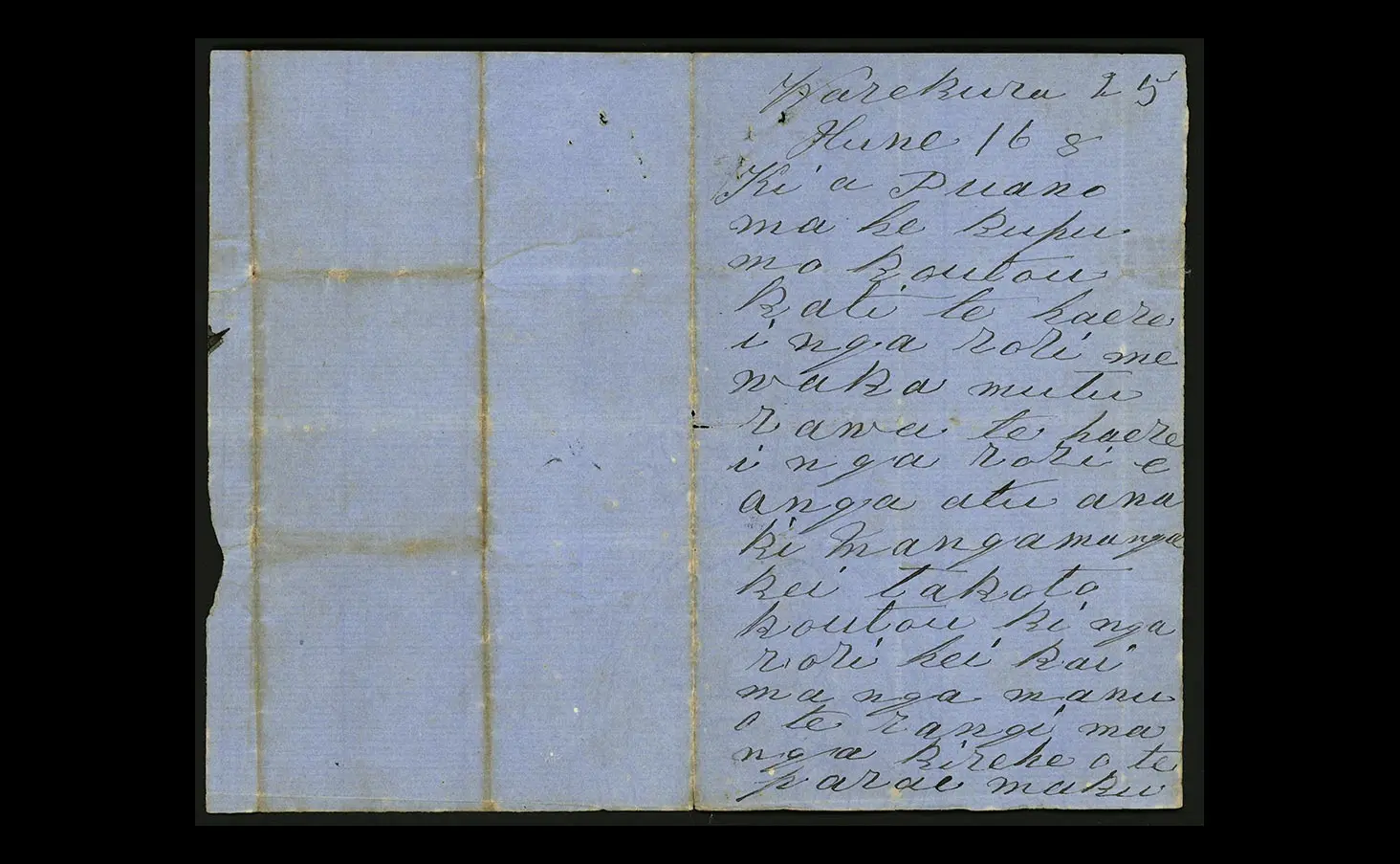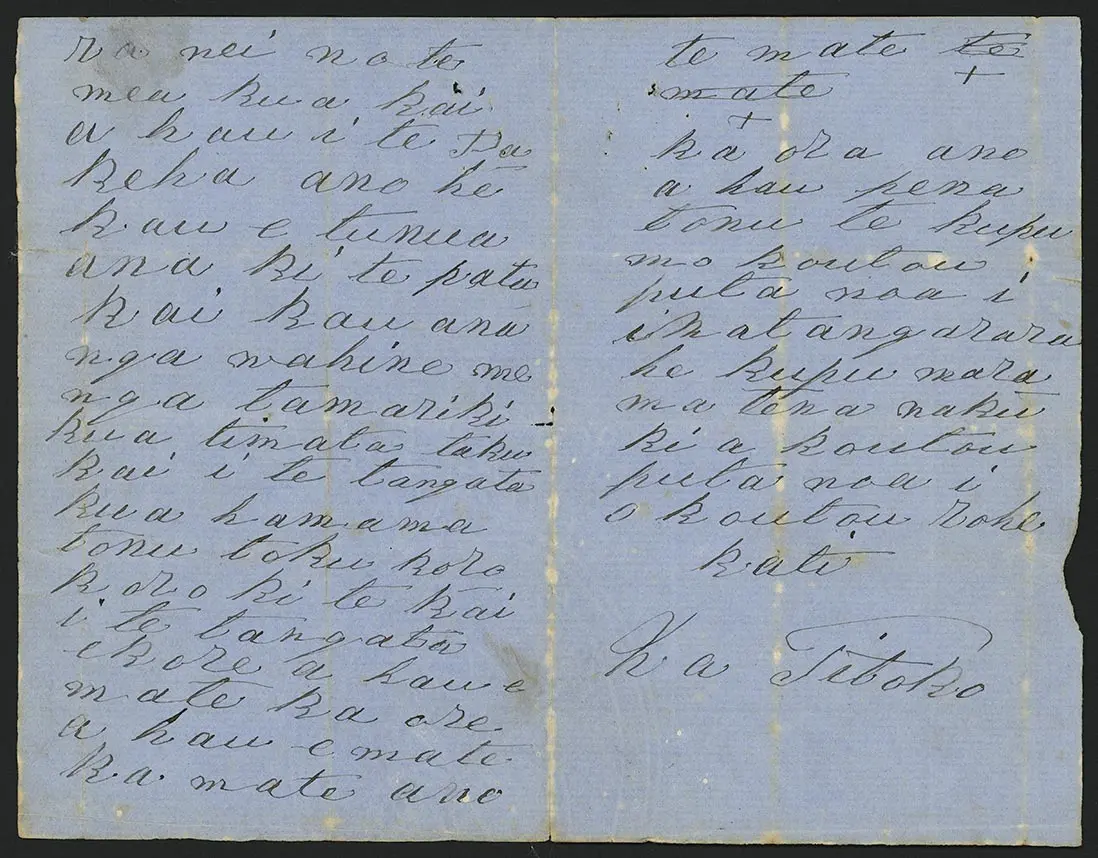Image credit: Page one of letter from Riwha Tītokowaru to his tribe (‘I shall not die’), 1868. Ref: MS-Papers-3006-01 Alexander Turnbull Library.

Image credit: Page one of letter from Riwha Tītokowaru to his tribe (‘I shall not die’), 1868. Ref: MS-Papers-3006-01 Alexander Turnbull Library.

Riwha Tītokowaru wrote defiant words in the face of increased confiscation of Māori land. Read about his military expertise and his support of non-violent resistance, including at Parihaka. Find out more by exploring our collections and curated resources.
‘E kore ahau e mate, kāore ahau e mate, ka mate anō te mate, ka ora anō ahau’ (‘I shall not die; I shall not die. When death itself is dead I shall be alive’). These ringing words of defiance were written in a letter found in a cleft stick on a south Taranaki road in June 1868. The letter — written by Ngāti Ruanui rangatira Riwha Tītokowaru (c. 1823–1888) — had an explosive effect.
Frustrated with the continued confiscation of his people’s land, Tītokowaru wanted to send a deterrent message to the Pākehā population and, by extension, the colonial government. A fortnight before the letter was written, a soldier called Tom Smith was killed when, disobeying orders, he went looking for his horse. Only the lower part of his body was found; the rest had been cooked and eaten in what historian Tony Sole has described as a terror tactic. Tītokowaru’s letter, which refers to this act, was designed to outrage and sow panic among Pākehā settlers and troops alike in the run-up to renewed armed resistance from iwi forces, led by the rangatira himself.
What followed was a series of battles in which Tītokowaru proved himself to be a brilliant military strategist. He achieved major wins over the colonial forces at a time when they were also battling military leader Te Kooti’s insurgency on the East Coast. But at the height of its success, Tītokowaru’s campaign ended abruptly — and at the time inexplicably — when he and his forces abandoned their pā at Tauranga-ika in 1869.
Tītokowaru’s words ‘I shall not die’ have become well known as the title of his 1996 biography by historian James Belich. Less well known is that Tītokowaru was borrowing from the whakataukī, ‘E kore au e mate, he kākano i ruia i Rangiātea’ (‘I shall not be lost, the seed that was sown from Rangiātea’). The reference to the ancestral homeland, Rangiātea, makes a powerful statement about the enduring survival of the Māori people and, in the case of the Taranaki wars, their resistance to land loss.
That resistance continued in the non-violent movement propounded by Te Whiti-o-Rongomai III and Tohu Kākahi from their papakāinga Parihaka, in which Tītokowaru took a leading part and for which he was imprisoned after Parihaka’s invasion in 1881. After his release the following year, Tītokowaru travelled with his followers throughout the Taranaki region preaching peace and reconciliation.
Story written by: Paul Diamond
Copyright: Turnbull Endowment Trust
Image credit: Page two and three of letter from Riwha Tītokowaru to his tribe (‘I shall not die’), 1868. Ref: MS-Papers-3006-02 Alexander Turnbull Library.

This letter by Riwha Tītokowaru was part of Alexander Turnbull’s original collection. It was given to him in 1916 by the surveyor and collector Gilbert Mair, who had his own notable career as a soldier in the New Zealand Wars.
Read connected stories from Te Kupenga:
Explore the Alexander Turnbull Library collections further:
Topic Explorer has:
Many Answers has Parihaka.
Want to share, print or reuse one of our images? Read the guidelines for reusing Alexander Turnbull Library images.
Tikanga ā-iwi:
Te whakaritenga pāpori me te ahurea
Te ao hurihuri.
Te Takanga o Te Wā (ngā hītori o Aotearoa):
Whakapapa
Mana motuhake.
Social sciences concepts:
Identity, culture, and organisation
Continuity and change.
Aotearoa New Zealand’s histories:
Māori history is continuous
Colonisation and its consequences
The exercise of power
Relationships and connections between people.